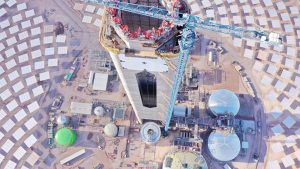This is one of the last milestones in the construction of the solar thermal project executed by Abengoa and Acciona in the Atacama Desert (Chile) and owned by EIG Global Energy Partners. Weighing 2,300 tons, this highly complex piece will concentrate the solar radiation reflected from the 10,600 heliostats that surround the tower. This is the first time this maneuver has been carried out in this kind of concentrating solar power project worldwide.

The Cerro Dominador solar thermal project, owned by EIG Global Energy Partners and built by Abengoa and Acciona in the Atacama Desert in Chile, has just achieved one of the key milestones of tis development before its entry into operation: the raising and installation of its solar receiver at 220 meters high. It was placed in the highest part of the central tower of the complex, which is surrounded by 10,600 heliostats.
The maneuver was completed in recent weeks, with the positioning of the receiver (piece of high complexity weighing 2,300 tons) in the foundation octagon, at 220 meters high in the central tower of the concentrated solar power plant. The function of the receiver is to concentrate the solar radiation reflected from the heliostats that are located around the 250-meter tower and heat the salts that will be stored to generate electricity.
The complete raising operation lasted a week, since the moment the receiver entered a cavity located at the base of the tower. Once inside, the receiver was raised to the top of the construction with 16 hydraulic industrial jacks. The ascent rate did not exceed five meters per hour, due to safety requirements and given the technical complexity of the entire procedure.
“We are very proud to have achieved this milestone. We continue advancing without pause in the construction of this iconic project for the region,” said Fernando González, CEO of Cerro Dominador.
"This is the first time this maneuver has been carried out worldwide in this type of project," as explained by Abengoa’s project manager on Cerro Dominador, Héctor Berlangieri, who also pointed out that the conceptual idea of the operation and the engineering came from the Spanish company.
On the other hand, Luis Pérez, site manager of Acciona in the project, explained the great technical complexity of this raising maneuver: “A total control is needed on the ascent rate of the receiver, limited to approximately six meters per hour. We are really proud to participate in such a unique project and the commitment we are all demonstrating to make it happen.”